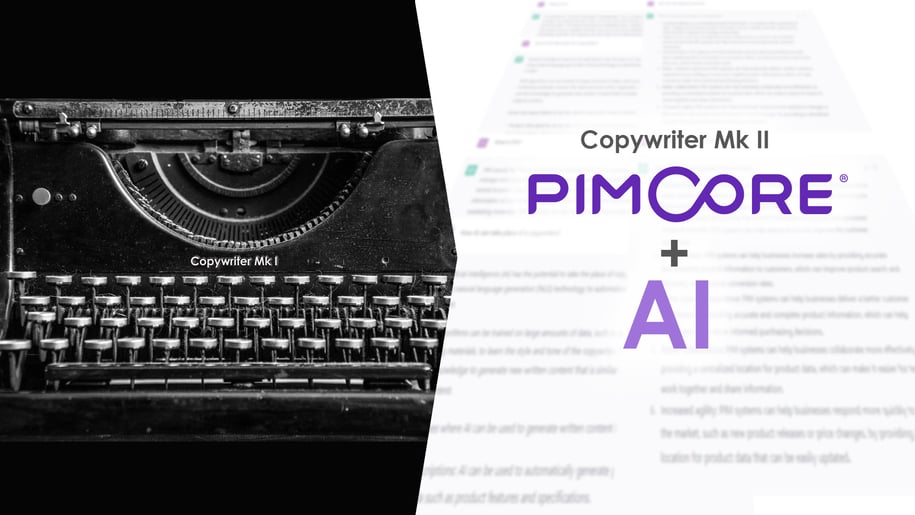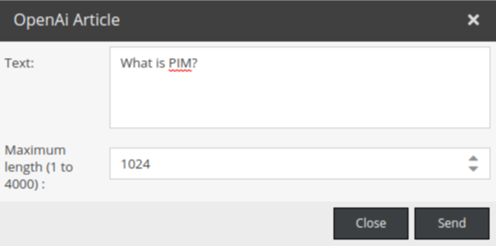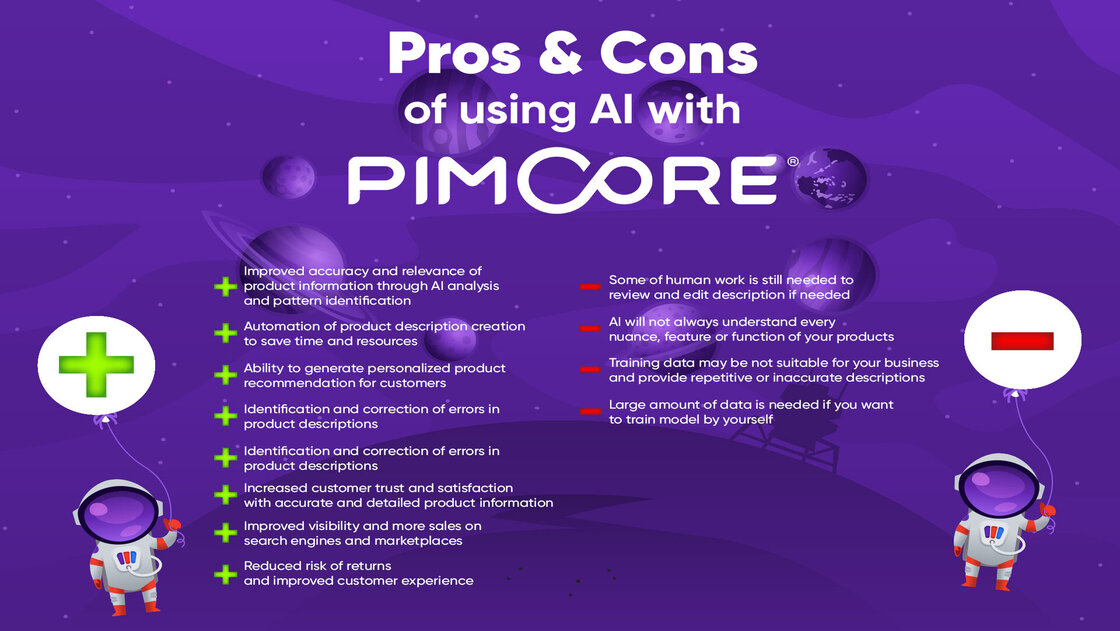
KI ist in der Lage, viele sich wiederholende Prozesse zu automatisieren. Insbesondere ressourcenintensive Aufgaben wie die Erstellung, Validierung und Korrektur von Produktbeschreibungen eignen sich für die Automatisierung. Für Unternehmen ist es wichtig, die Möglichkeiten abzuwägen, die moderne KI-Lösungen bieten.
Worunter leidet der eCommerce am meisten, wenn er genaue Produktdatenbeschreibungen benötigt?
Eines der kritischsten Probleme, die entstehen können, wenn eCommerce-Unternehmen korrekte Produktdatenbeschreibungen benötigen, ist ein Mangel an Kundenvertrauen und -zufriedenheit. Genaue und detaillierte Produktbeschreibungen sind unerlässlich, damit die Kunden eine fundierte Kaufentscheidung treffen können. Mit diesen Informationen können sich die Kunden von der Qualität, den Merkmalen und den Vorteilen des Produkts überzeugen, was zu einem Mangel an Vertrauen in das Unternehmen führen kann. Dies kann zu einer höheren Retourenquote, einer geringeren Kundentreue und einer niedrigeren Gesamtumsatzrate führen. Sind die Produktdaten zudem unvollständig oder ungenau, kann dies zu Problemen bei der Bestandsverwaltung und Auftragsabwicklung führen, was wiederum zusätzliche Kosten und betriebliche Probleme verursacht. Darüber hinaus können schlechte Produktdaten zu einer geringeren Sichtbarkeit und weniger Verkäufen in Suchmaschinen und auf Marktplätzen führen, da der Suchalgorithmus das Produkt möglicherweise nicht mit den Suchanfragen des Kunden abgleichen kann.
Warum KI zur Anreicherung von Produktbeschreibungen und was sind die Vorteile?
Es gibt mehrere Gründe, warum der Einsatz von KI zur Anreicherung von Produktbeschreibungen von Vorteil sein kann. Ein Grund ist, dass KI dabei helfen kann, die Genauigkeit und Relevanz von Produktinformationen zu verbessern, indem Daten analysiert und Muster erkannt werden. So kann sichergestellt werden, dass die Produktbeschreibungen korrekt und aktuell sind, was das Vertrauen und die Zufriedenheit der Kunden erhöhen kann. Außerdem kann KI den Prozess der Erstellung von Produktbeschreibungen automatisieren und so Zeit und Ressourcen sparen. Darüber hinaus kann KI dazu verwendet werden, personalisierte Produktempfehlungen für Kunden zu generieren, was die Kundenbindung und den Umsatz steigern kann. Und schließlich kann KI dabei helfen, Fehler in den Produktbeschreibungen zu erkennen und zu korrigieren, um das Kundenerlebnis zu verbessern und das Risiko von Rücksendungen zu verringern.
"Was wäre, wenn ich Ihnen sagen würde, dass es einen Texter gibt, der rund um die Uhr verfügbar ist und der fehlende Beschreibungen vervollständigen und die Datenqualität Ihrer Datenobjekte verbessern kann?"
Dieser Werbetexter ist OpenAI GPT-3. Schauen wir uns an, wie wir ihn in Pimcore integrieren können.
Was ist ein GPT-3 und wie kann es mit Pimcore verwendet werden?
Nach Angaben von OpenAI GPT-3 selbst:
"OpenAI GPT-3 (Generative Pre-trained Transformer 3) ist ein modernes Sprachverarbeitungsmodell, das von der Firma OpenAI entwickelt wurde. Es wurde mit einer riesigen Menge an Textdaten trainiert und kann menschenähnlichen Text erzeugen, Aufgaben wie Übersetzung und Zusammenfassung erledigen und auf Aufforderungen in einer konversationellen Weise reagieren. GPT-3 wurde mit einer Vielzahl von Internettexten trainiert, so dass es über ein breites Spektrum an Wissen und Verständnis verfügt."
- OpenAI GPT-3
Mit diesen leistungsstarken Fähigkeiten kann GPT-3 verwendet werden, um Produktbeschreibungen zu generieren oder bei der automatischen Erstellung von Inhalten zu helfen, und es kann auch verwendet werden, um bei der Verschlagwortung und Kategorisierung von Inhalten zu helfen. Heute werden wir darüber sprechen, wie wir es zur Generierung von fehlenden Produktbeschreibungen und zur Erstellung von Artikeln eingesetzt haben.
Verbesserung der Datenqualität durch Bereitstellung fehlender Beschreibungen
Jeder von uns ist schon einmal auf eine Situation gestoßen, in der viele Beschreibungen einfach fehlten. Aber wenn der Rest der Produktdaten vorhanden ist, können wir sie mit Hilfe von KI generieren
Die Grundidee war:
-
Wir verwenden die in Pimcore gespeicherten Attribute wie Farbe, Material, Abmessungen und Verwendungszweck, um eine Eingabeaufforderung zu erstellen, die von der KI zur Generierung von Text verwendet wird.
-
Dies kann automatisch geschehen, wenn die Beschreibung fehlt, oder bei Bedarf über eine Schaltfläche im Datenobjekt.
-
Die generierte Beschreibung kann von einem menschlichen Bearbeiter verwendet, geändert oder aktualisiert werden.
-
Wir können den Text auch generieren, indem wir die Eingabeaufforderung manuell eingeben.
Es gibt eine Vielzahl von Möglichkeiten, dies automatisch zu tun, wie z. B. Event Listener oder Value Provider. Wir haben uns jedoch für die "On-Demand"-Option entschieden und daher benutzerdefinierte Schaltflächen und Modelle in der Datenobjektansicht erstellt.

Nach dem Anklicken eines dieser Modelle können wir die erwartete Länge der Antwort konfigurieren (max. 4000 Zeichen). In der Artikelgenerierung können Sie manuell eine Eingabeaufforderung eingeben. Im Beschreibungsgenerator wird sie automatisch anhand der ausgefüllten Produktattribute erstellt.


Im Falle des Beschreibungsgenerators fragen wir einfach die KI über eine API mit einer generierten Frage, die auf Produktattributen basiert:
"Erstellen Sie eine Beschreibung für ein Produkt namens Cobra 427, das ein Sportwagen ist, Produktionsjahr ist 1966, Herkunftsland ist GB, und Karosserieform ist ein 2-türiger Roadster. Er hat 2 Türen, 2 Sitze, Hinterradantrieb, 8 Zylinder, einen vorne liegenden Motor, der 305 kW Leistung erzeugt."
Um es bequem zu machen, machen Sie es asynchron.
Eine Antwort von GPT-3 zu erhalten, kann einige Zeit in Anspruch nehmen, daher haben wir uns entschieden, Symfony Messenger in unsere Funktionalität einzubinden. Wenn du nicht weißt, was Symfony Messenger ist oder wie man es mit Pimcore benutzt, schau dir den Artikel von Mateusz Soroka darüber an.
Der Symfony Messenger erlaubt es uns, Operationen asynchron zu erledigen, der Benutzer erhält eine Benachrichtigung, dass sein Text in wenigen Sekunden fertig ist.

Wenn die Antwort fertig ist, egal ob es sich um eine Beschreibung oder den Inhalt eines Artikels handelt, werden die Objektfelder automatisch vom Symfony Messenger Handler aktualisiert.
%20(1).png)
Sind Menschen überflüssig? Brauchen wir sie noch im Prozess?
Wie bereits gesagt wurde, bringt die KI-Technologie eine Menge Vorteile mit sich, aber wir müssen auch einige Nachteile und Einschränkungen berücksichtigen. KI wird nicht immer jede Nuance, Eigenschaft oder Funktion Ihrer Produkte verstehen. Auch wenn sie auf der Grundlage riesiger Mengen von Textdaten trainiert wurde, ist sie nicht auf die spezifischen Bedürfnisse und Vorlieben einzelner Kunden und Unternehmen zugeschnitten. Wenn die Trainingsdaten veraltet oder nicht umfassend sind, sind die generierten Informationen möglicherweise nicht genau oder vollständig. KI kann auch Probleme haben, sehr spezifische technische Sprache und Terminologie zu verstehen, denn einige Produktbeschreibungen können sich zu sehr wiederholen, während andere sehr unterschiedlich sein können. Menschliche Redakteure sollten die von der KI generierten Texte immer noch überprüfen und bei Bedarf redigieren, aber wir können den Arbeitsaufwand für die Bereitstellung vollständiger Produktinformationen bereits reduzieren.
Zusammenfassung

Wir können KI für eine Reihe von Prozessen nutzen, von denen die meisten automatisiert werden können, wie z. B. die Erstellung, Validierung und Korrektur von Beschreibungen. Selbst wenn wir KI-Beschreibungen nur zur Erstellung von Beschreibungsentwürfen verwenden wollen, ist sie ein großartiges Werkzeug. Für Unternehmen ist es wichtig, die Vor- und Nachteile der Verwendung von generierten Produktinformationen abzuwägen und Maßnahmen zu ergreifen, um sicherzustellen, dass die bereitgestellten Informationen korrekt, vollständig und aktuell sind, um das bestmögliche Kundenerlebnis zu bieten. Es ist erwähnenswert, dass dies erst der Anfang dieser bereits erstaunlichen Technologie ist; wir können es kaum erwarten, zu sehen, was die Zukunft in dieser Angelegenheit für uns bringen wird und wie wir sie mit Pimcore nutzen werden!



.jpg?width=520&height=294&name=2024-05_Guest_Blog_Twocream_Header%20(1).jpg)